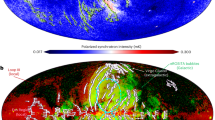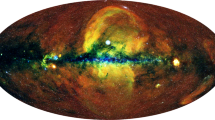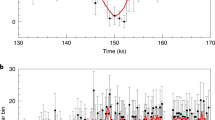Abstract
Overbeck1 has shown that small angle scattering of X rays by interstellar dust will tend to increase the apparent size of a point celestial X-ray source, the result being the formation of a halo around the source image. Although the exact description of this halo, which depends on the detailed properties of the dust and of the source, has been discussed2–6 no direct observational evidence for the existence of such haloes has been presented, although dust scattering has been invoked to explain the diffuse soft X-ray emission observed around the Crab Nebula during a lunar occultation7.I report here data obtained by the imaging proportional counter on board the Einstein Observatory8 of the bright X-ray source GX339–4 (4U1658–48). These data show a faint but apparently real X-ray halo around GX339–4. The principal uncertainty in the intensity distribution of the halo arises from the poorly determined spectrum of GX339–4 and it is likely that the parameters of the halo and of the derived model of the scattering dust grains may be improved in a future analysis using revised Einstein spectral calibration data; however, the range of allowed spectra leaves the reality of this first detection of an interstellar dust halo unchanged.
This is a preview of subscription content, access via your institution
Access options
Subscribe to this journal
Receive 51 print issues and online access
$199.00 per year
only $3.90 per issue
Buy this article
- Purchase on SpringerLink
- Instant access to full article PDF
Prices may be subject to local taxes which are calculated during checkout
Similar content being viewed by others
References
Overbeck, J. W. Astrophys. J. 141, 864 (1965).
Martin, P. G. Mon. Not. R. astr. Soc. 149, 221 (1970).
Martin, P. G. & Sciama, D. W. Astrophys. J. Lett. 5, L193 (1970).
Spiegelhauer, H. & Trumper, J. J. Br. interplanet. Soc. 28, 319 (1975).
Hayakawa, S. Prog. theor. Phys. 43, 1224 (1970).
Rolf, D. P. thesis, Leicester Univ. (1980).
Toor, A., Palmieri, T. M. & Seward, F. D. Astrophys. J. 207, 96 (1976).
Doxsey, R. et al. Astrophys. J. Lett. 228, L67 (1979).
Grindlay, J. E. Astrophys. J. Lett. 232, L33 (1979).
Samini, J. et al. Nature 278, 434 (1979).
Greenberg, J. M. in Cosmic Dust (ed. McDonnell, J. A. M.) 187–284 (Wiley, Chichester, 1978).
Trumper, J. & Schönfelder, V. Astr. Astrophys. 25, 445 (1973).
Mathis, J. S., Rumpl, W. & Nordsiek, K. H. Astrophy. J. 217, 425 (1977).
Author information
Authors and Affiliations
Rights and permissions
About this article
Cite this article
Rolf, D. Evidence for the detection of X-ray scattering from interstellar dust grains. Nature 302, 46–48 (1983). https://doi.org/10.1038/302046a0
Received:
Accepted:
Issue date:
DOI: https://doi.org/10.1038/302046a0



